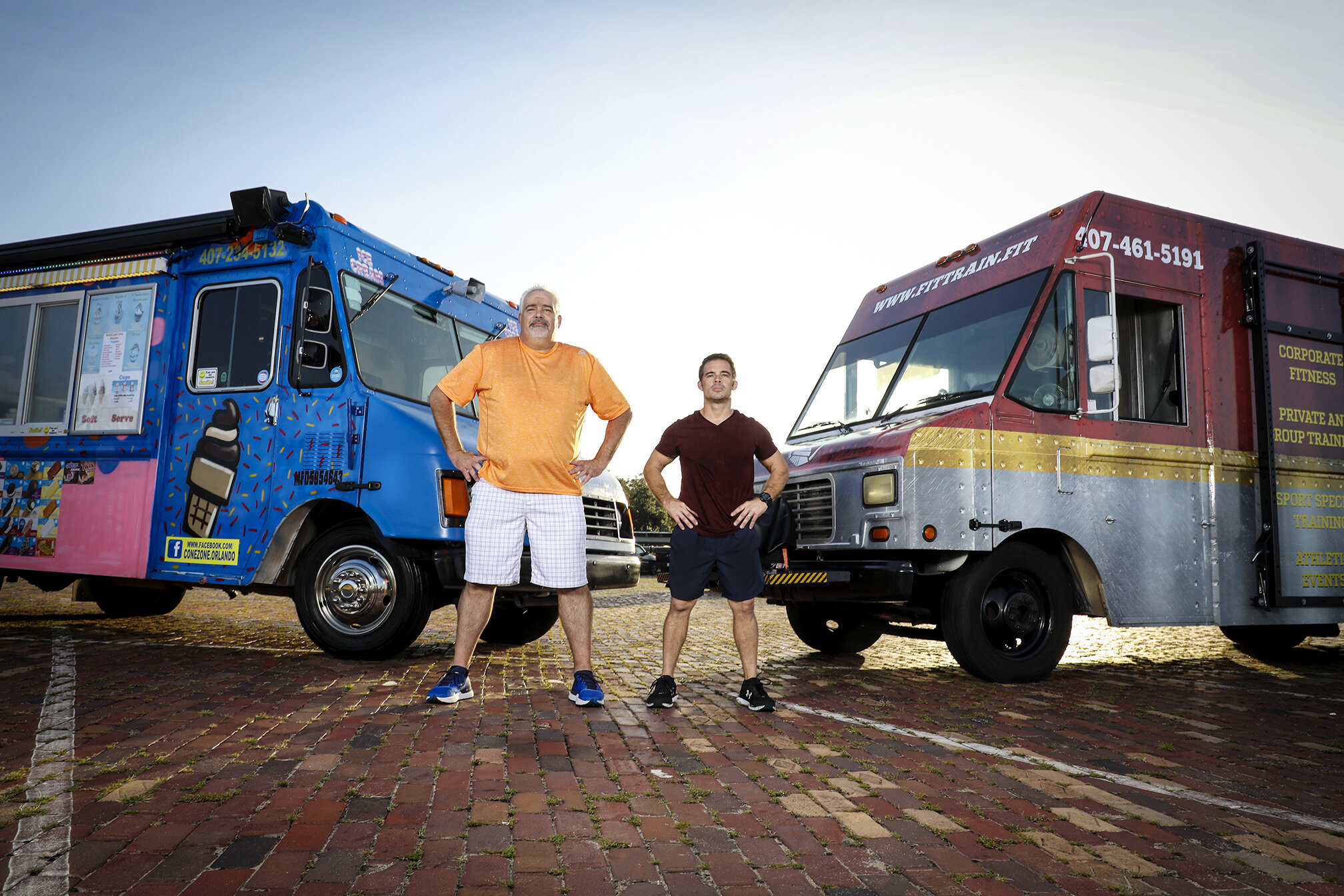Here's where I've landed on FitTrain. Plenty of trucks sell tacos. But the only one that sells ass kickings is right here in Orlando.
When Lisa Snyder stepped out of the Orlando Rowing Club’s boathouse one morning, she wasn’t expecting to find a group of her 50 and 60-year-old rowing partners in the parking lot, all gathered around a giant step truck.
She was puzzled. One of them worked battle ropes. Another did reps on a bench press. There were 7 or 8 of them, laboring together against medicine balls and barbells, slightly silhouetted against the sunrise over Lake Fairview.
This is how Snyder discovered The FitTrain. And she’s been a steadfast passenger ever since. Her and her friends, all willing participants in an odd fitness experiment happening nowhere else in the world. One that shouldn’t work. And yet, it does.
Chris Mink is the inventor and engineer of the FitTrain, an exercise physiologist with the restless heart of an inventor. He designed the truck on napkins, the preferred rough sketch medium of revolutionaries. He placed tape on his driveway to mark the footprint of the equipment he would eventually install on the sides of the 25-year-old truck.
“Some people thought I was crazy. Some thought it was the best idea ever, “ said Mink. “I just wanted to do something different.
By January, the last time 2020 was somewhat normal, the 4-cylinder diesel Chevy p30, formerly used in Frito Lay’s snack delivery fleet, was transformed into the FitTrain, perhaps a karmic reincarnation, a chance at redemption for a previous life spent delivering empty calories.
By February he had convinced some of his old clients to train with him and his absurd traveling gym. He had even managed to pick up a few new clients. But not enough. Until one day, Mink woke up in a lockdown.
By late March, every gym in town was closed. The world had stopped. But somehow, the FitTrain never did. Clients called. Clients came. They fled the gym cathedrals they attended religiously for what they believed to be safer pastures.
Soon after, Mink finds himself driving his truck to homes all over Orlando. He drives to a house where three generations of family members are hunkered down. He drives to parks to train groups of friends. He parks next to lakes and rivers and beaches. He parks at hotels and resorts. He trains military people for Officer Candidate School. He trains a youth group from an underserved part of the city. He trains grandmothers and millennials, experts and beginners.
It’s too early to say how disruptive Mink’s mobile fitness dream is to the $828 billion dollar physical activity market. He’s just one guy with a truck full of exercise stuff. But you won’t find anyone among the FitTrain’s current passengers who say they are disembarking once the pandemic passes.
Carol Posada, a 64-year-old trainer herself and a FitTrain regular, believes Mink is on to something.
“It’s not just a different gym each time,” said Posada. “It’s a different gym at a different address.”
Wendy Davis is part of the crew that wakes up in the pre-sunrise darkness to join friends at the FitTrain.
“My workout has also become my social hour,” said Davis. “We all laugh together, we walk a mile before and after, there’s a lot of conversation. For me there’s a new element to exercise now - laughter.”
For some, the FitTrain’s appeal is in the culture.
“Every gym has its own culture,” said Marni Spence, a 55-year-old exerciser with Mink’s 50+ group. “There are gyms where people really dress up.”
But the only mirror onboard the FitTrain is the rearview mirror, and it would appear that none of the FitTrain’s devotees are looking back to their previous workout lives.
Dr. Mary Cox, the Director at the Peggy and Philip Crosby Wellness Center in Orlando, offers another explanation for the exercise truck’s appeal.
“Thee’s something about the Hawthorne effect and exercise,” she said. “Most people perform better when they are being observed by others.”
Cox believes the FitTrain is a timely idea, one with viability even in a post-pandemic world. For those betting on the future of fitness, the winning side appears to be outside.
“Many of us need to trick ourselves into liking exercise,” said Cox. “That often means going outdoors. We need multiple venues. And (FitTrain) is one more opportunity to say, this is fun. This is different.”
It’s doubtful that any of Mink’s current clients are aware that they are part of what may become the future of fitness in this new we’ll-come-to-you economy. But it is apparent to all of them that there is something special about working out with a group of friends, outdoors, in and around an old snack delivery truck.
Mink says his cancellation rate is nearly 0%, a number unheard of in the fitness industry. He attributes much of that to the sense of accountability people within his groups have to each other.
With each stop, it is apparent that there’s no stopping the FitTrain, or the pandemic-produced fitness phenomenon that has captivated large swaths of Orlando’s exercising public.
A Tale of Two Trucks - The Ice Cream truck still reigns supreme. But a new truck serving up physical beatings is gaining more popularity every day. It’s called, the Fit Train. And you won’t get any soft serve.
